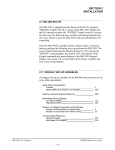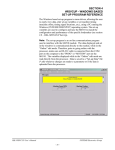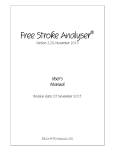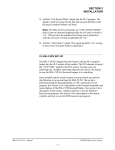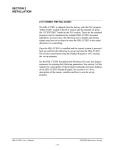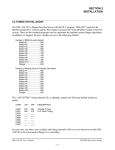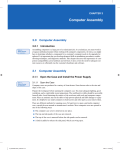Download SECTION 2 INSTALLATION - Sea
Transcript
SECTION 2 INSTALLATION 7) Add the “Alarm Reset” output. This signal should be “on” as long as the system reset push-button is depressed. ________________________________________________________ 2.8 HSL-WI3 SET-UP The HSL-WI3 is shipped from the factory with the PLC program “HSLWI3” loaded in the PLC section of the HSL-WI3 module and the PLS channel set-point file “WI7TMG” loaded in the PLS section. In most cases, the following user variables and timing channels may have to be altered to tune the HSL-WI3 to the actual bodymaker it is controlling. Once the HSL-WI3 is installed and the control system is powered back up, perform the following to set-up and tune the HSL-WI3. The set-up is performed using the Display/Keypad of the HSL-WI3 or a PC running the “HSLWI3” set-up program. See section 3 for a description of the Keypad commands and menu displays of the HSLWI3 Display/Keypad. See section 4 for a description of the menus, variables and how to use the Windows based set-up program. See section 5 for a description of the menus, variables and how to use the DOS based set-up program. ________________________________________________________ 2.8.1 DEFAULT SET-UP VARIABLES As shipped, the user variables for the HSL-WI3 are set to the following defaults: Brake Wear Compensation: Enabled Desired BDC Stop Position (Low Speed) Desired BDC Stop Position (High Speed) : N : 000 : 000 Maximum Allowed Stopping Response (degrees) : 300 Bodymaker Running Speeds: Low Speed (SPM) High Speed (SPM) : 250 : 350 Trimmer Speed Reference: Maximum Speed Idle Speed (W/I stopped) High Speed Offset : 375 : 250 : 20 HSL-WI3 User’s Manual SYSTEMS Electronics Group - 19 - SECTION 2 INSTALLATION The “WI7TMG” timing channel file, as shipped, contains the following default timing set-points: CHAN ON - OFF DESCRIPTION CH00: CH01: CH02: CH03: CH04: CH05: CH06: CH07: CH10: CH11: CH12: CH13: CH14: CH15: CH16: CH17: 150 180 155 110 230 150 120 180 000 ___ ___ ___ ___ ___ ___ ___ BDC (high) Timing BDC (low) Timing Short Can Check Timing Sensor Check Timing Cupfeed Timing Air Strip (low) Timing Air Strip (high) Timing PLC Clock Timing Motion (“on” for 30, “off” for 30 thru-out) spare spare spare spare spare spare spare - 170 200 175 130 300 200 190 000 030 ___ ___ ___ ___ ___ ___ ___ ________________________________________________________ 2.8.2 SET BODYMAKER SET-UP PARAMETERS The Bodymaker set-up parameters include: enabling or disabling the brake wear compensation, setting the desired low and high speed stopping points (if the brake wear compensation is enabled), setting the maximum allowed stopping response, and setting the bodymaker running low and high speeds. Brake Wear Compensation: If the brake wear compensation is to be used, enable it by setting the “Brake Wear Compensation Enable” to “Y”. Set the “Desired BDC Stop Position (Low)” and “(High)” as well if the compensation is enabled. The “Desired BDC Stop positions” are the location you want the ram to be at when it comes to rest after a BDC stop. Both the “Low” and “High” desired stopping positions are generally set to 000 degrees. Enabling the brake wear compensation allows the HSL-WI3 to automatically adjust the BDC timing channels (CH00-High) and (CH01-Low) as necessary such that the press will stop at the desired stopping position regardless of the actual brake response. HSL-WI3 User’s Manual SYSTEMS Electronics Group - 20 - SECTION 2 INSTALLATION If the brake wear compensation is not to be used, disable it by setting the “Brake Wear Compensation Enable” to “N”. Disabling the brake wear compensation requires the BDC (High) timing (CH00) and the BDC (Low) timing (CH01) signals to be set manually such that the press stops at BDC. Note: If the brake response then changes, the press will not stop at the desired position if the brake wear compensation is disabled. Maximum Allowed Stopping Response: This parameter defines what the maximum allowed brake response is before the “Brake Response Too Long” alarm is generated. If the actual brake response (number of degrees from when the brake is activated to the position where the press ends up at rest) when a BDC stop is performed is longer than this number, the alarm is generated. If the actual brake response is less, the alarm is not generated. Set this parameter to the value where the brake response is considered too long and service to the brake should be performed (typically 270 to 300 degrees). Bodymaker Running Speeds: Set the Bodymaker running “Low Speed” and “High Speed” to the speeds that the bodymaker will actually run at when the respective speed is selected. Note: This is not a speed reference that will make the bodymaker run at the speeds entered but is instead simply parameters used by the HSL-WI3 to know when to switch between the BDC (Low) and BDC (High) timing as well as the Air Strip (Low) and (High) timing etc. See section 3.4 (HSL-WI3 Keypad/Display) or section 4 (Windows based set-up program) or section 5 (DOS based set-up program) for details on setting the above set-up parameters. HSL-WI3 User’s Manual SYSTEMS Electronics Group - 21 - SECTION 2 INSTALLATION ________________________________________________________ 2.8.3 SET TRIMMER SPEED REFERENCES Set the “Trimmer Maximum Speed”, “Trimmer Idle Speed”, and “Trimmer High Speed Offset” as desired. These three parameters are used to actually control the speed of the trimmer (via the 0-10VDC trimmer speed reference output of the HSL-WI3 module). Trimmer Maximum Speed: The “Trimmer Maximum Speed” parameter is used to scale the 0-10VDC analog output such that when the bodymaker is running at the speed entered in “Trimmer Maximum Speed”, the analog output will be at 10 volts. Trimmer Idle (Minimum) Speed: This parameter determines the speed the trimmer will run at when the bodymaker is stopped (declutched). Note: When the bodymaker is running, the trimmer speed reference is proportional (as set by the “Trimmer Maximum Speed” scaling) to the speed of the bodymaker. This parameter is used to provide the speed reference when the bodymaker speed is zero. Trimmer High Speed Offset: This parameter is used to modulate the speed of the trimmer as a function of cans present at the infeed of the trimmer. A high infeed sensor can be added to the trimmer infeed such that the trimmer will run at the bodymaker running speed plus the “Trimmer High Speed Offset” value. This allows the trimmer to speed up when the infeed to the trimmer backs-up and slow down once the trimmer runs the cans out. See section 3.4 (HSL-WI3 Keypad/Display) or section 4 (Windows based set-up program) or section 5 (DOS based set-up program) for details on setting the above set-up parameters. ________________________________________________________ 2.8.4 SET MACHINE ZERO Inch the bodymaker to back dead center (BDC) and set the HSL-WI3 resolver offset per section 3.4 (HSL-WI3 keypad) or section 4 (Windows based set-up program) or section 5 (DOS based set-up program). HSL-WI3 User’s Manual SYSTEMS Electronics Group - 22 - SECTION 2 INSTALLATION ________________________________________________________ 2.8.5 VERIFY LOCATION OF SHORT CAN TIMING (CH02) By inching the machine, verify that the “Short Can” timing (CH02) of the HSL-WI3 first turns “on” when the short can sensor is over the nose of the punch on the forward portion of the stroke (see figure 2). This would be where the sensor would first “see” the can as it emerges from the die set. Verify that the “Short Can” timing turns “off” right before the sensor would quit seeing the lip of the can as the ram continues it's forward motion. Adjust either or both of the turn “on” or turn “off” locations of CH02 until the above is achieved. Depending on the location of the short can sensor, CH02 is typically set “on” at 155 degrees and then back “off” at 175 degrees. ________________________________________________________________________________ Figure 2 - Short Can Check Timing Sequence HSL-WI3 User’s Manual SYSTEMS Electronics Group - 23 - SECTION 2 INSTALLATION Note: The short can sensor must “see” can the entire time the “Short Can” timing (CH02) is “on” in order to pass the short can check. Otherwise, the “Short Can” alarm will be generated. At this time, also verify that the “Sensor Check” timing (CH03) is also set correctly. This timing signal should go “on” for 20 degrees then back “off” just prior to the punch emerging from the die set (typically 110 to 130 degrees). This signal is used to verify that the short can sensor has not failed “on” and therefore the short can sensor must be “off” the entire time CH03 is “on” otherwise the “Die Sensor Fail” alarm is generated. See section 3.4 (HSL-WI3 Keypad/Display) or section 4 (Windows Based set-up program) or section 5 (DOS Based set-up program) for details on setting CH02 and CH03. ________________________________________________________ 2.8.6 VERIFY MACHINE OPERATION Once steps 2.8.2 thru 2.8.5 are complete, run the machine in normal production (both at low and high speeds where practical) and verify the following: Verify Air Strip Timing: With the machine running, with the cupfeed open, verify that the cans are stripped with-out any problems and that no blow-outs are occurring (verify at both low and high speed if a problem is occurring, adjust the respective “Air Strip” timing (CH05-Low Speed, CH06-High Speed) until the problem is corrected. See section 3.4 (HSL-WI3 Keypad/Display) or section 4 (Windows based set-up program) or section 5 (DOS based set-up program) for details on adjusting CH05 and CH06. Verify Short Can Timing: With the machine running with the cupfeed open, verify that no false short can faults are occurring (short can alarm occurs when full length can is made). If false short can alarms are occurring, narrow the short can timing one degree at a time until the false short can alarms quit occurring. HSL-WI3 User’s Manual SYSTEMS Electronics Group - 24 - SECTION 2 INSTALLATION Verify that the short can detection is working correctly by generating a short can and verifying that the short can alarm is generated for this can. This can be done by stopping the press, removing one of the die rings then punching a cup in single stroke mode with the die ring removed. The short can alarm should be generated when the first cup is punched. Verify BDC Stops: If the brake wear compensation is enabled, verify that the press does stop at the desired location in both the high and the low speeds. Note: When the HSL-WI3 is first installed, it will take a few successive stops for the algorithm to program the BDC timing channels to the correct position. The compensation is enabled after the press has been running at a fixed speed in continuous. The BDC timing channels will not be modified when single strokes are made or if press is started in continuous and then immediately stopped again. Wait about 5 seconds after the press is started before performing the BDC stop to verify the stop position. If the brake wear compensation is disabled, manually adjust both the BDC (High) timing (CH00) and the BDC (Low) timing (CH01) such that the press stops at back dead center at both respective speeds. See section 3.4 (HSL-WI3 Keypad/Display) or section 4 (Windows based set-up program) or section 5 (DOS based set-up program) for details on adjusting CH00 and CH01. The Machine Is Now Set-Up and Ready To Run. HSL-WI3 User’s Manual SYSTEMS Electronics Group - 25 -










